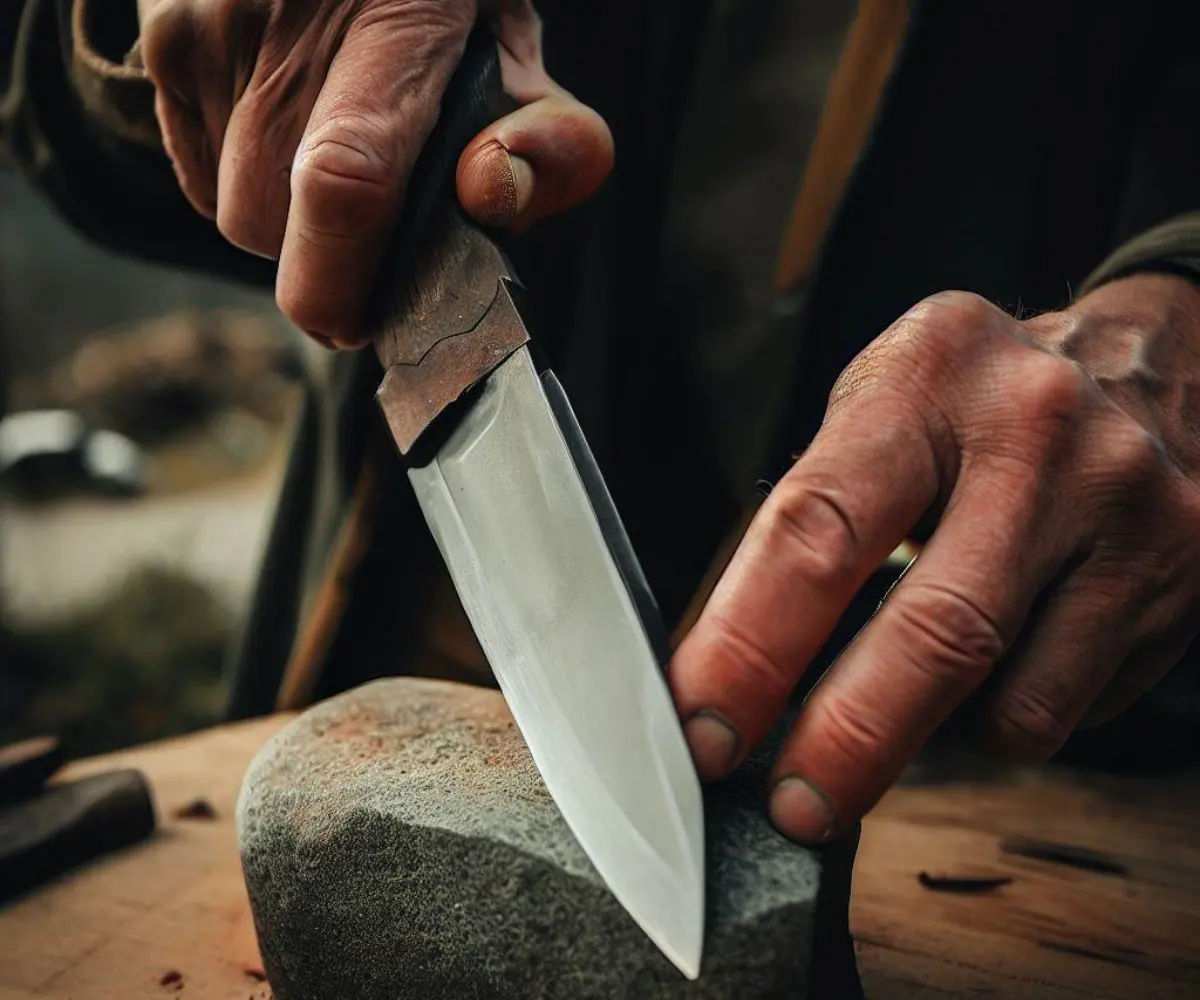Knowing how to sharpen a hunting knife is an essential skill for hunters, campers, and outdoor enthusiasts. A sharp knife is not only more effective but also safer to use.
In this guide, we’ll walk you through the process of sharpening your hunting knife, ensuring that you have the right tools and techniques at your disposal.
From selecting the right sharpening stone to understanding the importance of grit size, we’ll cover everything you need to know. Whether you’re a seasoned hunter or a beginner, this comprehensive guide will help you master the art of sharpening your hunting knife.
Let’s dive into the details and explore the step-by-step process, tips, tricks, and answers to frequently asked questions.
How to Choose the Right Sharpening Tool
Topics Covered In This Article
- 1 How to Choose the Right Sharpening Tool
- 2 How to Sharpen a Hunting Knife : Step-by-Step Guide
- 3 Tips
- 4 Frequently Asked Questions
- 5 Conclusion
- 5.1 Related Articles:
- 5.1.1 How to Sharpen a Hunting Knife Efficiently
- 5.1.2 What Should Sportsman Consider When Hunting from a Boat?
- 5.1.3 How to Remove Hunter Douglas Blinds
- 5.1.4 Can You Shoot a Bounty Hunter on Your Property?
- 5.1.5 What Are Limiting Factors in Hunting?
- 5.1.6 How to Clean Hunter Boots?
- 5.1.7 Does Walmart Sell Hunting Licenses?
- 5.1.8 Best Hunting Sunglasses
- 5.1.9 What Color Lenses Are Best for Hunting Glasses?
- 5.1 Related Articles:
Selecting a Sharpening Stone
A sharpening stone is a must-have for anyone looking to sharpen a hunting knife. The type of stone you choose can significantly impact the sharpening process. Whetstones are popular and come in various grit sizes. Diamond stones are known for their durability and precision, while ceramic stones offer a smooth sharpening experience. Consider the type of steel your knife is made from and your sharpening skill level when selecting a stone. Investing in a quality stone will ensure that you can sharpen your hunting knife effectively and maintain its performance over time.
Understanding Grit Size
The grit size of the sharpening stone affects how finely the knife is sharpened. A lower grit number, such as 100 or 200, will remove more material and is suitable for repairing chips or reshaping the blade. A higher grit number, like 1000 or 2000, will polish the blade and refine the edge. It’s essential to start with a coarser grit and gradually move to a finer one to achieve a razor-sharp edge. Understanding grit size and how it impacts the sharpening process will help you select the right stone and technique for your specific hunting knife.
How to Sharpen a Hunting Knife : Step-by-Step Guide
Step 1: Preparing the Stone
Before you begin sharpening, it’s crucial to prepare the stone according to the manufacturer’s instructions. If using a whetstone, soak it in water for at least 5-10 minutes. For oil stones, apply a thin layer of honing oil. Proper preparation ensures that the stone provides a smooth and consistent sharpening surface. It also helps prevent the stone from wearing unevenly. Make sure to place the stone on a stable surface, and consider using a stone holder for added stability.
Step 2: Finding the Correct Angle
Finding the correct angle is vital when learning how to sharpen a hunting knife. A 20-degree angle is generally ideal for hunting knives, providing a balance between sharpness and durability. You can use an angle guide or practice by hand to find the right angle. Consistency is key, so take your time and ensure that you maintain the same angle throughout the sharpening process. An incorrect angle can lead to an uneven edge or even damage the blade, so pay close attention to this step.
Step 3: Sharpening the Blade
Sharpening the blade requires patience and precision. Hold the knife at the correct angle and slide it across the stone in a sweeping motion. Apply moderate pressure and repeat this process on both sides of the blade. It’s essential to count the number of strokes on each side to maintain an even edge. Feel for a burr, a rough edge that forms on the opposite side of the blade, as this indicates that you’ve sharpened enough on that side. Sharpening the blade properly will ensure that your hunting knife is ready for any task.
Step 4: Honing the Edge
After sharpening, honing the edge is the final step to achieving a razor-sharp blade. Use a honing rod or a higher grit stone to remove any burrs and polish the blade. Gentle, controlled strokes are key to honing the edge without removing too much material. This step refines the edge and aligns the microscopic teeth of the blade, enhancing its cutting performance. Regular honing can also extend the time between sharpening sessions, keeping your hunting knife in top condition.
Tips
- Maintain consistent pressure and angle throughout the sharpening process.
- Use a sharpening guide if you’re new to sharpening knives.
- Regular maintenance will keep your knife in top condition.
- Test the sharpness by slicing through a sheet of paper or shaving a small piece of wood.
- Always clean the knife and sharpening tools after use to prevent rust and maintain their longevity.
Frequently Asked Questions
Can I use a regular stone to sharpen my hunting knife?
While it’s possible to use a regular stone, using a specialized sharpening stone will yield better results. Regular stones may not have the proper grit size or consistency needed for sharpening a hunting knife. Investing in a quality sharpening stone designed for knives ensures that you can achieve a sharp and even edge.
How often should I sharpen my hunting knife?
The frequency of sharpening depends on how often you use your hunting knife and the tasks you perform with it. Regular use may require sharpening once a month, while occasional use may only require sharpening a few times a year. Regular honing can extend the time between sharpening sessions. Monitoring the performance of your knife and sharpening it as needed will keep it in optimal condition.
What’s the difference between honing and sharpening?
Sharpening removes material from the blade to create a new edge, while honing aligns the existing edge without removing material. Sharpening is done with a coarse stone and requires more pressure, while honing is done with a finer stone or honing rod and requires gentle strokes. Honing should be done more frequently than sharpening to maintain the edge’s performance.
Can I damage my knife by sharpening it incorrectly?
Yes, incorrect sharpening can cause chipping, uneven wear, or even permanent damage to the blade. Using the wrong angle, excessive pressure, or an inappropriate sharpening stone can lead to these issues. Following the proper technique and using the right tools will prevent damage and ensure that your hunting knife remains in top condition.
Is there a way to test if my knife is sharp enough?
Testing the sharpness of your knife is an essential part of the sharpening process. The paper test, where you try to slice through a sheet of paper, is a common method. A sharp knife will cut through the paper smoothly and without tearing. Other methods include shaving a small piece of wood or even gently running your thumb across the edge (with caution). Regular testing helps you gauge when it’s time to sharpen or hone your knife.
Conclusion
Understanding how to sharpen a hunting knife is a valuable skill that enhances safety and efficiency. By following this comprehensive guide, selecting the right tools, and practicing the steps, you’ll master the art of sharpening your hunting knife. Whether you’re preparing for a hunting trip or maintaining your tools for everyday use, a sharp knife is essential. Give it a try, and experience the difference a sharp blade can make. Remember, regular maintenance and proper technique are key to preserving the life and performance of your hunting knife.
Related Articles:
How to Sharpen a Hunting Knife Efficiently
What Should Sportsman Consider When Hunting from a Boat?
How to Remove Hunter Douglas Blinds
Can You Shoot a Bounty Hunter on Your Property?
What Are Limiting Factors in Hunting?
How to Clean Hunter Boots?
Does Walmart Sell Hunting Licenses?
Best Hunting Sunglasses
What Color Lenses Are Best for Hunting Glasses?

Walter Hendricks is a well-known authority in the eyewear industry, specializing in a diverse range of products such as gaming glasses, swimming goggles, sunglasses, eyeglasses, computer glasses, and fashionable daily-wear eyewear.
Hendricks believes in empowering his readers with in-depth information to help them choose the right glasses that blend functionality and fashion, catering to their unique lifestyle requirements.
His comprehensive reviews and informative articles provide clear insights on everything from cutting-edge gaming glasses to the latest trends in eyewear fashion. Through his work, Hendricks has proven his dedication to helping consumers make informed eyewear decisions that support both their visual needs and style preferences.

